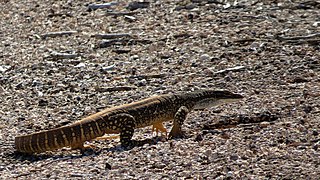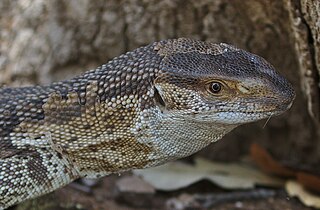
Monitor lizards are lizards in the genus Varanus, the only extant genus in the family Varanidae. They are native to Africa, Asia, and Oceania, and one species is also found in the Americas as an invasive species. About 80 species are recognized.

The Nile monitor is a large member of the monitor family (Varanidae) found throughout most of Sub-Saharan Africa, particularly in drier regions, and along the Nile River and its tributaries in East Africa. Additionally, there are modern, invasive populations in North America. The population found in West African forests and savannahs is sometimes recognized as a separate species, the West African Nile monitor. While it is dwarfed by its larger relatives, such as the Komodo dragon, the Asian water monitor or the crocodile monitor, it is still one of the largest lizards in the world, reaching Australia’s perentie in size. Other common names include the African small-grain lizard, as well as iguana and various forms derived from it, such as guana, water leguaan or river leguaan.

The sand goanna, also known commonly as Gould's monitor, the racehorse goanna, and the sand monitor, is a species of large Australian monitor lizard in the family Varanidae.

The savannah monitor is a medium-sized species of monitor lizard native to Africa. The species is known as Bosc's monitor in Europe, since French scientist Louis Bosc first described the species. It belongs to the subgenus Polydaedalus.

The yellow-spotted monitor, also known as the Argus monitor, is a monitor lizard found in northern and western regions of Australia and southern New Guinea.

The white-throated monitor is a lizard found in southern Africa. They are usually gray-brown with yellowish or white markings, and can reach up to 2 metres (6.6 ft) in length. They are found in Southern Africa, northwards to Angola, Zambia, and Mozambique.

The rock monitor is a species of monitor lizard in the family Varanidae. The species is endemic to Sub-Saharan Africa, where, on average it is the largest lizard found on the continent. It is called leguaan or likkewaan in some areas.

The Kimberley rock monitor is a medium-sized species of monitor lizard in the family Varanidae. The species is native to Northern Australia. Also known commonly as Glauert's monitor and the Kakadu sand goanna, it belongs to the subgenus Odatria.

The peach-throated monitor, also known as the Sepik monitor, is a species of monitor lizard native to New Guinea.
The Pilbara monitor, also known commonly as Bush's monitor, Bush's pygmy monitor, and the Pilbara mulga goanna, is a species of monitor lizard in the family Varanidae. The species is endemic to Australia.

The yellow-headed water monitor, also commonly known as Cuming's water monitor, the Mindanao water monitor, and the Philippine water monitor, is a large species of monitor lizard in the family Varanidae. The species is endemic to the Philippines. It thrives in mangrove, forest and water margins in tropical refuges, where it feeds on birds, fishes, mammals, and carrion.
The black-spotted ridge-tailed monitor, also called commonly the black-spotted spiny-tailed monitor, the lemon-throated monitor, the northern ridge-tailed monitor, Whites monitor, and the yellow-throated monitor, is a subspecies of lizard in the family Varanidae. The subspecies is native to Australia's tropical Northern Territory. It is listed as Least Concern on the IUCN Red List as it is considered common and not threatened. It was first described in 1987. It is also known as White's dwarf goanna.

The blue-tailed monitor, blue-tailed tree monitor or Kalabeck's monitor, is a monitor lizard of the Varanidae family. It belongs to the V. doreanus group of the subgenus Euprepiosaurus.

Dumeril's monitor is a species of lizard in the family Varanidae. The species is endemic to Southeast Asia.
Finsch's monitor is a species of monitor lizard in the family Varanidae. The species is native to New Guinea and Australia.

Kings' monitor, also known commonly as Kings' goanna, Kings' rock monitor and pygmy rock monitor, is a small species of monitor lizard in the family Varanidae. The species is native to Australia.
Varanus rainerguentheri, also commonly known as Günther's mangrove monitor and Rainer Günther's monitor, is a species of lizard in the family Varanidae. The species is endemic to the Moluccas.

Varanus reisingeri, known commonly as Reisinger's tree monitor and the Yellow tree monitor, is a species of monitor lizard in the family Varanidae. The species is endemic to Indonesia. It was at one point at least considered an allopatric insular subspecies of the green tree monitor, due to physical and genetic similarities.














